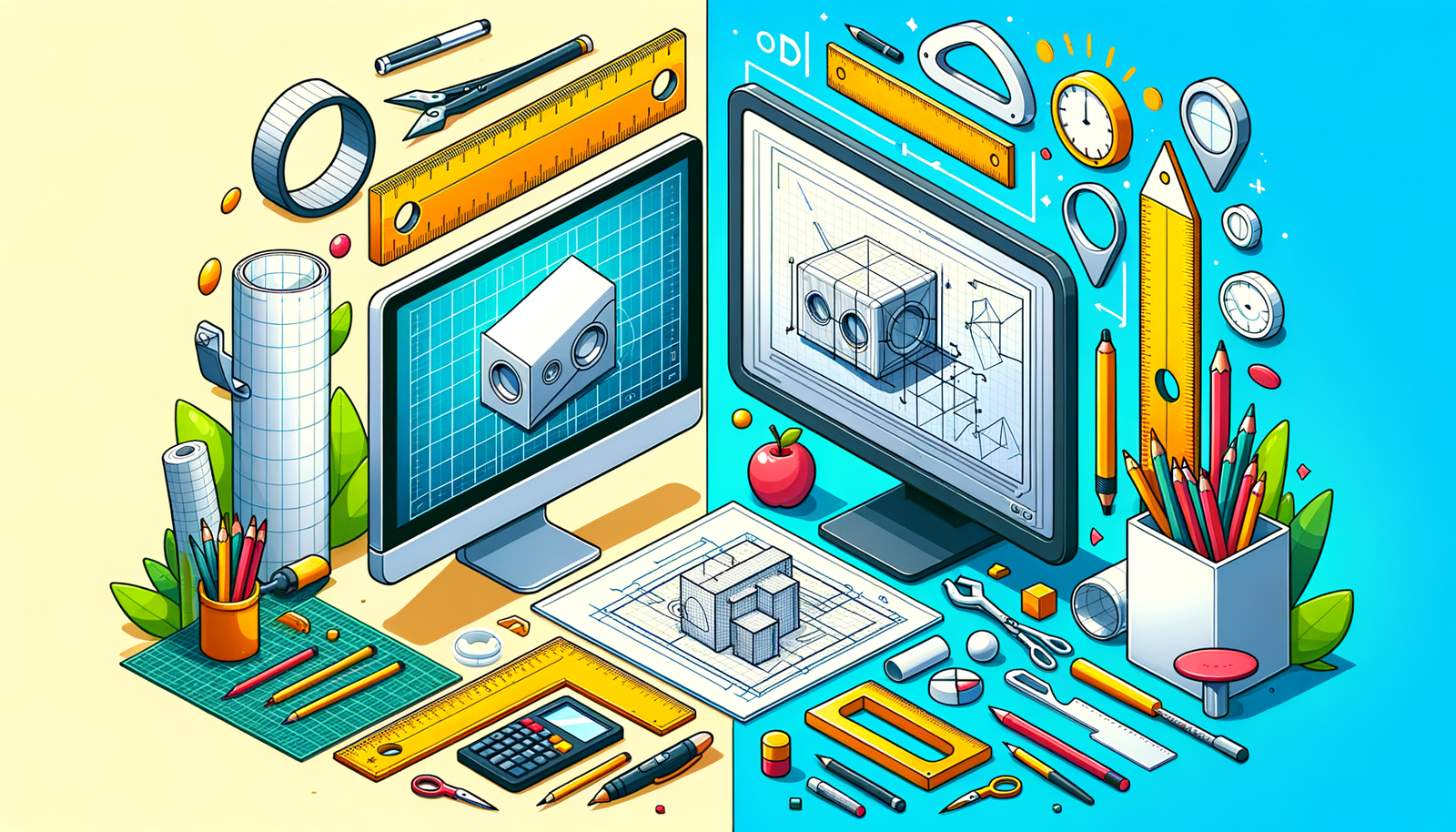Your Cart is Empty
Customer Testimonials
-
"Great customer service. The folks at Novedge were super helpful in navigating a somewhat complicated order including software upgrades and serial numbers in various stages of inactivity. They were friendly and helpful throughout the process.."
Ruben Ruckmark
"Quick & very helpful. We have been using Novedge for years and are very happy with their quick service when we need to make a purchase and excellent support resolving any issues."
Will Woodson
"Scott is the best. He reminds me about subscriptions dates, guides me in the correct direction for updates. He always responds promptly to me. He is literally the reason I continue to work with Novedge and will do so in the future."
Edward Mchugh
"Calvin Lok is “the man”. After my purchase of Sketchup 2021, he called me and provided step-by-step instructions to ease me through difficulties I was having with the setup of my new software."
Mike Borzage
Design Software History: The Evolution of Design Software in Virtual Reality Gaming: From Early Prototypes to Immersive Experiences
May 14, 2025 8 min read


Introduction and Historical Context
The evolution of virtual reality gaming has been a fascinating journey marked by innovation, persistence, and groundbreaking advancements in both hardware and software sectors. In the earliest days of VR, design software served as the backbone for researchers and developers who sought to create an immersive digital experience, laying the foundation for today’s robust environments. Early prototypes were often constrained by limited computing power and simplistic graphical rendering tools, yet these obstacles ignited the imagination of engineers and visionaries alike. The synergy between nascent design software and emerging VR hardware was instrumental in defining the aesthetic and operational principles of immersive environments. These tools allowed developers to experiment with spatial design, simulate physics, and produce interactive scenarios that pushed the boundaries of what was possible.
Foundational Challenges in Early Integration
During the initial exploration of VR, developers encountered a formidable set of challenges that tested the limits of available technology. The integration of design software with nascent VR hardware required not only a rethinking of traditional two-dimensional computer-aided design (CAD) paradigms but also the adaptation of complex mathematical models for real-time simulation. These early systems often relied on basic rendering capabilities that were not equipped to handle the depth, motion, and interaction levels that immersive environments demand today. This era of experimentation was characterized by a series of trial-and-error approaches, where pioneers in the field had to balance innovation with the technical limitations of their time. With each new iteration of hardware, the role of design software was recontextualized, evolving from a mere drafting tool into an essential component for creating dynamic, interactive spaces.Impact of Early VR Prototypes on Design Software
In addition to overcoming technical hurdles, early VR prototypes sparked a cultural revolution in game design and interactive storytelling. The software provided the means to simulate environments that otherwise existed only in theory, encouraging a community of developers to explore uncharted territories. Key challenges included real-time interaction with complex objects, integrating digital physics simulations, and ensuring that the user experience remained smooth and lifelike even on hardware with limited processing power. These hurdles inspired the adoption of innovative programming practices and fostered an environment where experimental design methodologies could flourish. Furthermore, the ongoing collaboration between hardware manufacturers and software engineers laid the groundwork for future breakthroughs that continuously redefined the realms of what VR technology could accomplish.Technological Milestones and Breakthroughs
The technological evolution of design software for VR gaming is characterized by a series of critical milestones that have collectively transformed the industry. The shift from basic rendering tools to advanced, real-time simulation software represented a quantum leap. Initially, design software was limited to static models and rudimentary animations, but as computing power increased, developers began to implement sophisticated algorithms that allowed for real-time physics simulations and dynamic rendering. One of the most influential turning points in this evolution was the integration of engines capable of real-time physics and haptic feedback, which enabled immersive and interactive VR environments that responded to user input with surprising fidelity. Additionally, advancements in 3D modeling and stereoscopic visualization helped bridge the gap between two-dimensional design plans and the three-dimensional spaces that gamers could eventually explore. These advancements were underpinned by increasingly complex mathematical models that borrowed from computational geometry and physics, ensuring that every simulated interaction adhered to the laws of motion and spatial reality.
From Basic Rendering to Advanced Simulations
The transformation from basic rendering tools to software capable of handling real-time simulations was not an overnight shift; it was the result of decades of relentless engineering effort and incremental improvements. In the early stages, the limitation was evident in the inability to render smooth, continuous motion in three dimensions. Design engineers worked to develop new algorithms that could simultaneously process vast arrays of data in real time, a challenge that required innovative solutions in optimization and resource management. Some of the most notable breakthroughs involved the development of graphics rendering engines that used polygon-based models, eventually paving the way for more complex procedures like voxel-based rendering and ray tracing. By integrating these methods, design software evolved to support complex visualizations that could accurately simulate lighting, shadows, texture, and even nuanced reflections.Innovations Driving Immersive Interactivity
Another significant breakthrough came with the development of engines incorporating real-time physics calculations and haptic feedback mechanisms. These software innovations directly contributed to creating more immersive VR experiences by ensuring that users could interact with virtual objects in ways that closely mimic their real-world counterparts. In response to the demand for heightened realism, developers began integrating components that offered tangible feedback, such as simulated force interactions and responsive environmental elements. With constant iterations in design and the introduction of cloud-based computation, the industry witnessed a leap in the capabilities of VR software, effectively transforming virtual worlds into spaces where every movement could be mathematically and physically replicated. Furthermore, major innovations in stereoscopic visualization provided a depth of immersion that was previously unattainable, giving users a convincing sense of three-dimensional space within the digital realm.Role of Mathematical Models and Computational Geometry
Underpinning many of these breakthroughs were developments in the fields of computational geometry and mathematical modeling. Early VR development relied on relatively simple mathematical representations to handle spatial relationships and object dynamics. However, as the demands of immersive environments increased, more sophisticated models were required to accurately simulate phenomena such as gravitational forces, collision detection, and fluid dynamics. Developers had to innovate novel approaches that exploited key mathematical theories to enhance the realism of these simulations. Among these, the algorithms that allowed for real-time computations of complex shapes and curvatures played a pivotal role, breathing life into the digital environments. Further, the integration of haptic feedback through precise mathematical models fostered a closer union between virtual designs and tactile responses, marking a significant milestone in the history of VR gaming design software.Influential Companies, Pioneers, and Trends
The narrative of design software in virtual reality is deeply intertwined with the contributions of visionary companies and pioneering individuals who pushed the limits of technological innovation. Many of these early innovators emerged from specialized VR gaming labs and independent software studios that were willing to challenge conventional methods. Companies such as Autodesk, Dassault Systèmes, and Adobe have been instrumental in propelling design software from rudimentary drafting tools to comprehensive suites that integrate simulation, modeling, and interactive feedback. Their contributions provided the **technical framework** that modern VR environments stand upon, redefining how virtual spaces are conceptualized, designed, and experienced. Key trends in the industry have consistently revolved around fostering collaborations between traditionally disparate fields such as hardware manufacturing, software development, and digital content creation. This collaborative spirit meant that groundbreaking technological breakthroughs could be achieved by combining resources and expertise from multiple disciplines.
Notable Industry Pioneers and Their Impact
The influence of industry pioneers cannot be overstated. Visionaries like Jaron Lanier and Ivan Sutherland made seminal contributions that laid the groundwork for many present-day VR technologies. Their early experiments and research not only demonstrated the potential of VR but also identified critical challenges in integrating digital environments with the human sensory system. Pioneers in the software space, including key teams at companies like Silicon Graphics Inc. and NewTek, developed early prototypes that explored real-time simulation and immersive interactivity. Their relentless experimentation and innovative designs pushed boundaries, inspiring subsequent generations of engineers and developers to further refine the interaction between hardware and design software. These collaborative efforts were often characterized by bullet points of breakthrough innovations, such as:- Creation of real-time rendering engines
- Implementation of neural network approaches to design simulations
- Integration of cloud-based collaboration tools in digital fabrication
- Adoption of advanced computational geometry models
Trends Shaping VR Design Software Development
Observing the evolution of VR design software highlights several trends that have carried forward into modern VR development. One significant trend is the constant cross-pollination between different industries. The integration of **digital fabrication techniques** alongside cloud-based development environments has enabled a more agile and iterative design process. Developers now have access to tools that allow for immediate feedback and collaborative design efforts regardless of geographical boundaries. Similarly, the adoption of neural network approaches within design software has not only increased the speed of rendering but has also introduced a level of creativity that traditional computational methods struggled to achieve. These methods facilitate enhanced pattern recognition and optimization in virtual spaces, ensuring that interactive elements respond with lifelike precision. Additionally, the cultural impact of VR design software has contributed to a distinctive visual aesthetic and narrative style in gaming, intertwining **immersive storytelling** with cutting-edge technology.Collaborative Breakthroughs in Design and Gaming
Collaborative efforts between gaming studios and software developers have consistently been at the forefront of innovation in VR technologies. By combining the creative vision of game designers with the technical expertise of software engineers, the industry has seen a rapid evolution in the tools used to create immersive digital environments. This synergy has led to the formation of interdisciplinary teams that value innovation and experimentation. It is through these collaborations that advancements in real-time simulation, as well as extensive use of cloud-based tools for concurrent development, were achieved. Bulletin points that exemplify the collaborative nature of this evolution include:- Joint efforts in developing photorealistic rendering engines
- Sharing of proprietary algorithms that enabled next-generation physics simulations
- Adapting modular software components for enhanced scalability in design applications
- Integrating neural network frameworks to voorspelling and refine user experience
Conclusion
As the virtual reality gaming industry continues to evolve, the historical timeline of design software remains a testament to human ingenuity and technological persistence. Early pioneers laid the groundwork by tackling immense challenges and integrating **computer-aided design** with evolving immersive technologies. Through the decades, technological milestones such as real-time rendering engines, advanced physics simulations, and the incorporation of neural network-based optimizations have continuously redefined the field, establishing a legacy that shapes modern VR environments. Every innovation, from the first crude prototypes to today’s hyper-realistic digital spaces, serves as a reminder of the transformative journey that design software and its development have undergone.
Reflection on Historical Advancements
The collective efforts of innovative companies and pioneering figures have undeniably paved the way for the high-caliber immersive experiences available in contemporary VR gaming. The continuous interplay between software development and hardware advancements forged a path where ambitious design ideas could transition from abstract concepts to tangible, interactive realities. Additionally, constant cross-disciplinary collaborations and the integration of new computational methods have ensured that the evolution of design software is not only about technological progression but also about enhancing the narrative and aesthetic depth of virtual environments. Through iterative learning, trailblazers in the field have repeatedly redefined the boundaries of what is technologically possible, leaving a lasting impression on both the industry and the culture of interactive design.Future Trends and Ongoing Synergy
Looking forward, the trajectory of VR design software points towards even greater interactivity and immersive experiences. Emerging technologies such as augmented reality integration, **real-time cloud computing**, and enhanced haptic feedback systems are poised to further blur the lines between digital and physical realities. In the coming years, designers will likely harness advanced computational geometry and neural network algorithms in unprecedented ways, pushing the envelope of what’s possible in immersive storytelling and interactive design. These advancements underscore an ongoing synergy between technological innovation and creative exploration, where each breakthrough not only builds on past achievements but also inspires future innovation. With each new development, the rich history of VR design software provides both a roadmap and a source of inspiration for the creators of tomorrow, ensuring that the industry will continue to evolve in ways that captivate our imaginations and redefine our understanding of virtual reality.Also in Design News

Revolutionizing Product Development: The Rise of Virtual Prototyping in Modern Design Software
May 14, 2025 10 min read
Read More
ZBrush Tip: Maximize Organic Modeling in ZBrush with Sculptris Pro Techniques
May 14, 2025 2 min read
Read More
Revit Tip: Enhancing Site Design Efficiency in Revit: Key Strategies and Best Practices
May 14, 2025 2 min read
Read MoreSubscribe
Sign up to get the latest on sales, new releases and more …


